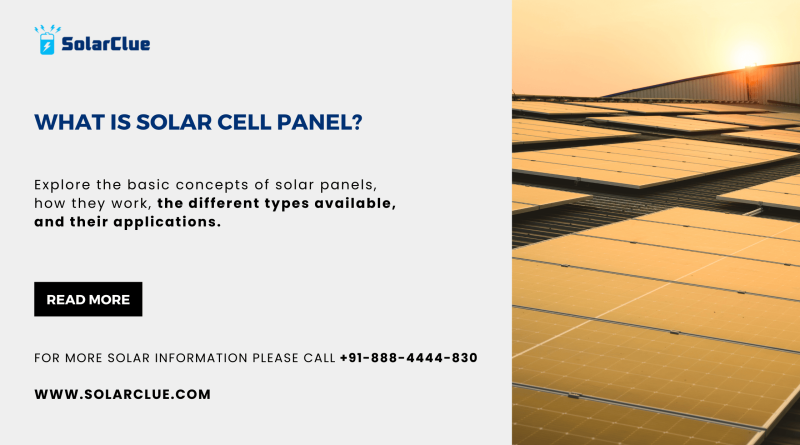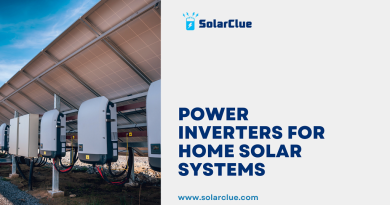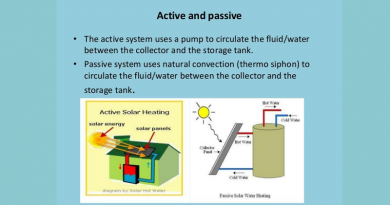What Is Solar Cell Panel?
Solar panels are devices that convert sunlight into electricity, providing a renewable and sustainable energy source. This blog will explain the basic concepts of solar panels, how they work, the different types available, and their applications.
Table of Contents
The Photovoltaic Effect and How it Works
The photovoltaic (PV) effect is the process by which solar panels convert sunlight into electricity. When sunlight hits the solar cells in a panel, it excites the electrons, creating an electric current. This current is captured and used as electricity.
The Structure of a Solar Panel
Solar panels are made up of several components that work together to generate power:
1. Solar Cells: The core component, usually made of silicon, where the photovoltaic effect occurs.
2. Glass: Protects the solar cells from environmental factors while allowing sunlight to pass through.
3. Frame: Provides structural support and allows for easy mounting.
4. Backsheet: Protects the underside of the panel.
5. Encapsulant: Holds the cells in place and protects them from moisture and dirt.
6. Junction Box: Houses the electrical connections and diodes.
Different Types of Solar Panels
Monocrystalline Solar Panels
- Description: Made from a single crystal structure.
- Efficiency: High, around 15-22%.
- Appearance: Uniform dark look.
- Advantages: Long lifespan, high efficiency, space-efficient.
- Disadvantages: Higher cost.
Polycrystalline Solar Panels
- Description: Made from multiple crystal structures.
- Efficiency: Moderate, around 13-18%.
- Appearance: Speckled blue look.
- Advantages: Lower cost, good efficiency.
- Disadvantages: Slightly lower efficiency than monocrystalline.
Thin-Film Solar Panels
- Description: Made by depositing thin layers of photovoltaic material on a substrate.
- Efficiency: Lower, around 10-12%.
- Appearance: Flexible, can be made into various shapes.
- Advantages: Lightweight, flexible, lower cost.
- Disadvantages: Lower efficiency, shorter lifespan.
| Feature | Monocrystalline Solar Panels | Polycrystalline Solar Panels | Thin-Film Solar Panels |
|---|---|---|---|
| Description | Made from a single crystal structure | Made from multiple crystal structures | Made by depositing thin layers of photovoltaic material on a substrate |
| Efficiency Range | 15-22% | 13-18% | 10-12% |
| Appearance | Uniform dark look | Speckled blue look | Flexible, various shapes |
| Advantages | High efficiency, long lifespan, space-efficient | Lower cost, good efficiency | Lightweight, flexible, lower cost |
| Disadvantages | Higher cost | Slightly lower efficiency than monocrystalline | Lower efficiency, shorter lifespan |
| Typical Applications | Residential rooftops, commercial installations, solar farms | Residential rooftops, commercial installations, solar farms | Large-scale installations, flexible applications, areas with low-light conditions |
| Cost | Higher | Moderate | Lower |
Advantages and Disadvantages of Solar Panels
Advantages
- Renewable Energy Source: Sunlight is abundant and free.
- Reduces Electricity Bills: Generates your own electricity, reducing dependence on the grid.
- Low Maintenance Costs: Minimal upkeep required after installation.
- Environmentally Friendly: Reduces carbon footprint and greenhouse gas emissions.
Disadvantages
- High Initial Cost: Installation and equipment can be expensive.
- Weather Dependent: Efficiency drops on cloudy or rainy days.
- Space Requirements: Requires significant space for installation.
- Energy Storage Costs: Storing solar energy in batteries can be expensive.
Common Uses for Solar Panels
Residential
- Rooftop Installations: Power homes and reduce electricity bills.
- Solar Water Heaters: Heat water for domestic use.
- Off-Grid Systems: Provide power in remote areas without access to the grid.
Commercial
- Large-Scale Installations: Power commercial buildings, reducing operational costs.
- Solar Farms: Generate electricity for sale to the grid.
Industrial
- Large-Scale Energy Production: Power industrial processes and reduce energy costs.
- Hybrid Systems: Combine solar with other energy sources for reliable power.
The Future of Solar Panel Technology
The future of solar panel technology looks promising, with continuous advancements aimed at improving efficiency and reducing costs. Innovations such as bifacial panels, perovskite solar cells, and integrated solar technologies (like solar windows) are on the horizon, making solar energy more accessible and efficient.
Conclusion
Solar panels are a key component of renewable energy solutions, converting sunlight into electricity through the photovoltaic effect. With various types of panels available, they can be tailored to different needs and applications. As technology advances, solar panels will continue to play a crucial role in sustainable energy production.
Here at SolarClue®, we offer a smart, practical, and “beautiful” solution. You will be answered for all the questions related to Solar.
We provide all kinds of brands that are the Best Solar panels in India.
If you are the one who is planning for the solar power system. Don’t hesitate to contact our team!
Looking forward to empowering you with solar energy, just like hundreds of our other clients!
FAQs
1. What is a solar panel?
A device that converts sunlight into electricity using the photovoltaic effect.
2. How do solar panels generate electricity?
By exciting electrons in solar cells when exposed to sunlight, creating an electric current.
3. What are the main types of solar panels?
Monocrystalline, polycrystalline, and thin-film.
4. What are the advantages of using solar panels?
Renewable energy source, reduces electricity bills, low maintenance, environmentally friendly.
5. What are the disadvantages of solar panels?
High initial cost, weather-dependent efficiency, space requirements, energy storage costs.



